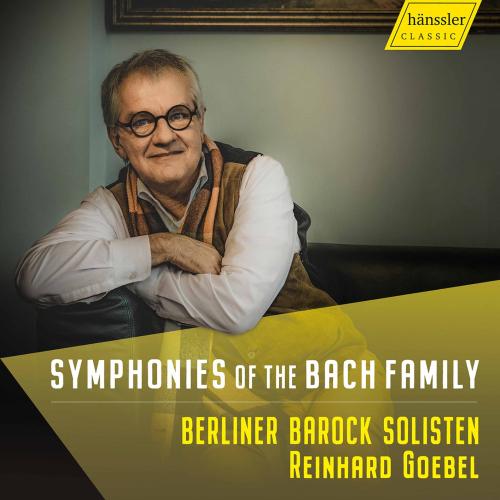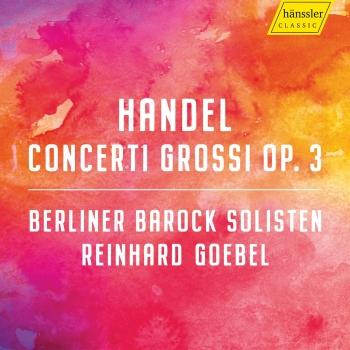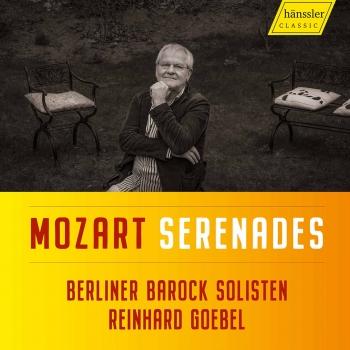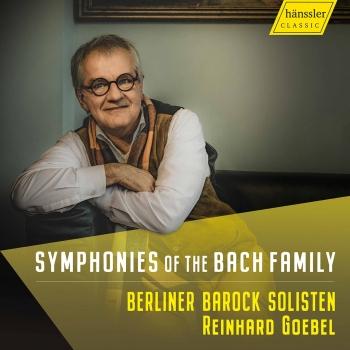
Symphonies of the Bach Familiy Berliner Barock Solisten & Reinhard Goebel
Album info
Album-Release:
2022
HRA-Release:
04.02.2022
Label: haenssler CLASSIC
Genre: Classical
Subgenre: Chamber Music
Artist: Berliner Barock Solisten & Reinhard Goebel
Composer: Wilhelm Friedemann Bach (1710-1784), Carl Philipp Emanuel Bach (1714-1788), Johann Christoph Friedrich Bach (1732-1795), Johann Sebastian Bach (1685-1750)
Album including Album cover Booklet (PDF)
- Wilhelm Friedemann Bach (1710 - 1784): Sinfonia in D Major, C8:
- 1 Bach: Sinfonia in D Major, C8: I. Moderato 02:47
- 2 Bach: Sinfonia in D Major, C8: II. Andante e piano sempre 02:43
- 3 Bach: Sinfonia in D Major, C8: III. Vivace 03:21
- Carl Philipp Emanuel Bach (1714 - 1788): Sinfonia in E-Flat Major, Wq. 122/2:
- 4 Bach: Sinfonia in E-Flat Major, Wq. 122/2: I Allegro ma non molto 02:24
- 5 Bach: Sinfonia in E-Flat Major, Wq. 122/2: II. Andante 03:21
- 6 Bach: Sinfonia in E-Flat Major, Wq. 122/2: III. Allegro assai 02:59
- Sinfonia in C Major:
- 7 Bach: Sinfonia in C Major: I. Allegro 03:06
- 8 Bach: Sinfonia in C Major: II. Andante e piano 02:34
- 9 Bach: Sinfonia in C Major: III. Presto 02:06
- Sinfonia in E Minor, Wq. 177:
- 10 Bach: Sinfonia in E Minor, Wq. 177: I. Allegro assai 04:04
- 11 Bach: Sinfonia in E Minor, Wq. 177: II. Andante moderato 02:02
- 12 Bach: Sinfonia in E Minor, Wq. 177: III. Allegro 03:59
- Johann Christoph Friedrich Bach (1732 - 1795): Sinfonia in D Minor, WFV I:3:
- 13 Bach: Sinfonia in D Minor, WFV I:3: I. Allegro 03:30
- 14 Bach: Sinfonia in D Minor, WFV I:3: II. Andante amoroso 02:34
- 15 Bach: Sinfonia in D Minor, WFV I:3: III. Allegro assai 02:12
- Sinfonia in B Major, B.C. BR-JEB C 1:
- 16 Bach: Sinfonia in B Major, B.C. BR-JEB C 1: I. Allegro 02:36
- 17 Bach: Sinfonia in B Major, B.C. BR-JEB C 1: II. Andante 01:57
- 18 Bach: Sinfonia in B Major, B.C. BR-JEB C 1: III. Allegro 02:16
- Johann Ludwig Bach (1677 - 1731): Concerto in D Major, JLB 39:
- 19 Bach: Concerto in D Major, JLB 39: I. Allegro 03:48
- 20 Bach: Concerto in D Major, JLB 39: II. Andante 01:55
- 21 Bach: Concerto in D Major, JLB 39: III. Allegro 01:29
- Johann Sebastian Bach (1685 - 1750): Sinfonia in D Major, BWV 1045:
- 22 Bach: Sinfonia in D Major, BWV 1045 05:43
Info for Symphonies of the Bach Familiy
Family portrait: Every generation creates its own forms of expression Often, this happens in abrupt rejection of what has gone before And not infrequently, the provocative gestures in which a new attitude to life is articulated disappear again just as quickly as they appeared Such thoughts may also have moved Johann Sebastian Bach when, in the early 1740s, his two eldest sons took up the genre of the symphony, which had come from Italy and was accompanied by a novel treatment of the orchestra and compositional technique Together with their generational peers, they created an independent line of tradition that was later referred to by music historians as the “symphony of the North German school” Johann Abraham Peter Schulz described the essence of the symphony in Johann Georg Sulzer’s ‘General Theory of the Fine Arts’ (1771-1774) in the following words: “The chamber symphony achieves its final aim wholly through a sonorous, brilliant and fiery style of writing The allegros contain great and bold thoughts, free treatment of the movements, apparent disorder in melody and harmony, strong and significant rhythms of various kinds, strong bass melodies and unisons, sudden transitions and digressions from one tone to another, which are all the more striking the flimsier their connection often is In addition, there is the art of combining all the voices in and with each other in such a way that their combination allows only a single melody to be heard, which is not capable of any accompaniment, but to which each voice contributes only its own sound ”
"In addition one work by the patriarch, this CD features compositions by his sons, a nephew, and a distant relative. Reinhard Goebel and the Berlin Baroque Soloists invest themselves fully in the music. Joy of playing and elastic-gestural virtuosity come into their own as well as the serious serenity of some movements. The perfect balance between the instrumental groups is striking, but the inner instrumental coherence is also stupendous: each string team actually plays ‘as one man’. The fact that spontaneity is fully preserved in this technical refinement shows how outstandingly well the various works have been rehearsed. The sound produced is clear and at the same time of pleasant fullness. The sound engineers have also given their best." (Remy Franck, pizzicato.lu)
Berliner Barock Solisten
Reinhard Goebel, musical direction
Berliner Barock Solisten
There are plenty of early music ensembles making the rounds nowadays. Many of them play quite appealingly, and some of them exhibit a topnotch standard of musicianship. However, only few of them display a level of artistic mastery akin to that of the Berliner Barock Solisten, founded in 1995 by Rainer Kussmaul and other prominent members of the Berlin Philharmonic. These musicians have joined their talents in creating a unique approach to the musical works of the 1600’s and 1700’s.
The “Berlin Baroque Soloists” not only do true honor to their name, since each one of them is a true bravura player. They also play on old but modernized instruments, using bows from different periods (depending on the work they are performing). Such flexibility, along with the ensemble’s exceptional homogeneity and the presence of leading early music soloists within its ranks, have contributed towards establishing this group’s leading position on the international scene. Just as their stylistic assuredness that permits them to practically “transfer” compositions from ages long past into our day and age, without damaging the historical veneer that covers them, nor ignoring the historical period in which they were written. Old sounds are thus heard with fresh ears. Works of the past are reconsidered in a new light – resulting in an interpretation that can be regarded as modern, yet certainly not ‘modernistic’; a style that spans the ages, fully valid both then and now. The Berliner Barock Solisten are capable of applying this approach to a number of composers, be it the creations of Italian masters, or the music of Telemann (for whom they have a special liking), that of Johann Sebastian Bach or of his contemporaries. For each individual piece they find a unique, inimitable tone.
Consistently applied over the last sixteen years, this unique approach to performance has led to a stupendous degree of recognition and approval on the part of audiences and critics alike. On concert podiums from Tokyo or Seoul to Berlin, from London to New York, from Paris to Shanghai as well as in a number of smaller towns – everywhere the Berliner Barock Solisten perform, they have left an indelible musical mark, ensuring that the ranks of their true fans are continually enlarged. Their programs are documented on numerous CD recordings whose exceptional quality has been widely acknowledged by music critics. Thus, the Berliner Barock Solisten were awarded a Grammy for their 2005 release of Bach cantatas, along with the German recording industry’s Echo Classic Prize for two successive CD’s featuring solo concertos by Telemann.
Such success can also be attributed to the outstanding artists who performed with the ensemble: singers such as Thomas Quasthoff, Christine Schäfer, Dorothea Röschmann, Christiane Oelze, Marc Padmore and Michael Schade, wind soloists of the likes of Emmanuel Pahud, Jacques Zoon, Albrecht Mayer, Jonathan Kelly, Maurice Steger, Michala Petri and Reinhold Friedrich, violinists such as Frank-Peter Zimmermann, Daishin Kashimoto and Daniel Hope as well as harpsichordist Andreas Staier.
Booklet for Symphonies of the Bach Familiy













